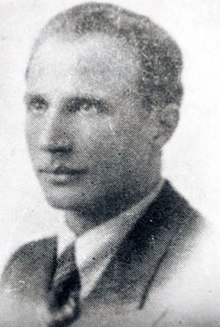Vasyl Sydor
Vasyl Sydor | |
|---|---|
 Vasyl Sydor | |
| Born | February 24, 1910 Spasiv, Austria-Hungary |
| Died | April 14, 1949 (aged 39) |
| Cause of death | Killed in combat with Soviet troops |
| Nationality | Ukrainian |
| Other names | Shelest, Vyshyty, Konrad, Zov |
| Organization | Ukrainian Insurgent Army |
| Political party | OUN-revolutionary |
Vasyl Sydor (Ukrainian: Василь Сидор); born in Spasiv (Спасів), 24 February 1910; died 14 April 1949 in Rozhniativ Raion – colonel of the Ukrainian Insurgent Army (UPA), political activist, soldier of the Nachtigall Battalion, commandant of Sotnia 201 Schutzmannschaft auxiliary police, vice-commander of UPA and leader of UPA-West for Eastern Galicia during World War II. Sydor was killed in combat with Soviet troops in the Limnytsia River Valley.[1]
Political significance
On September 1, 1944, Vasyl Sydor (Shelest) as the UPA commander for Eastern Galicia, issued an order to end "mass anti-Polish actions" within the borders of postwar Poland, thereby focusing on resistance rather than ethnic cleansing.[2] Murders of civilians continued, but only in retaliation.[3] From then on, UPA units began concentrating on attacking those who served with the pro-Soviet forces (although it took several months for the orders to reach individual commanders in the field).[2] In 1945 the AK issued a manifesto calling for an end to fighting between Poles and Ukrainians and for cooperation, printed it in 7,500 copies and distributed it in the surrounding villages.[4] At the same time, the leadership of UPA in the region made similar moves aimed at the same goal. After mediation by Catholic and Orthodox clergy, a meeting was arranged in Puszcza Solska (Solska Forest) between the commanders of both groups.[4] The top commander on the Polish side was Marian Gołębiewski (Ster) and on the Ukrainian side Jurij Lopatynsky (Szejk).[2] On the night of 27 May 1946 AK-WiN and UPA conducted their one-and-only joint operation against the communist forces of UB and NKVD in Hrubieszów. They parted their ways the next morning after a successful attack.[2]
References
- ^ "Sydor, Vasyl" at online Encyclopedia of Ukraine
- ^ a b c d "Biuletyn IPN, Nr 8, September 2001, pg. 25-32". (1.14 MB) (1.14 MB)
- ^ Timothy Snyder, "The Reconstruction of Nations" (PDF). Archived from the original (PDF) on 2011-08-19. Retrieved 2010-11-09. (5.74 MB) Yale University Press, New Haven, 2003. (5.74 MB)
- ^ a b Rąkowski, Grzegorz (2006). Polska egzotyczna: przewodnik, Part 2 (in Polish). p. 244. ISBN 9788389188564.
- 1910 births
- 1949 deaths
- People from Sokal Raion
- People from the Kingdom of Galicia and Lodomeria
- Ukrainian Austro-Hungarians
- Ukrainian nationalists
- Ukrainian people of World War II
- Organization of Ukrainian Nationalists politicians
- Massacres of Poles in Volhynia
- Commanders of the Ukrainian Insurgent Army
- Ukrainian collaborators with Nazi Germany
